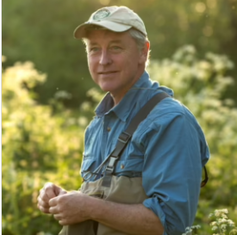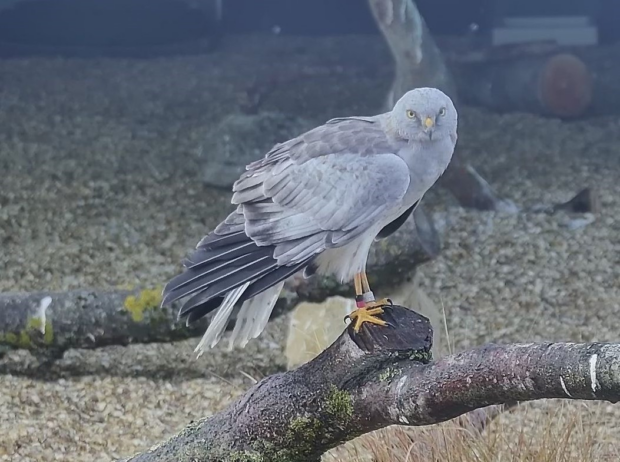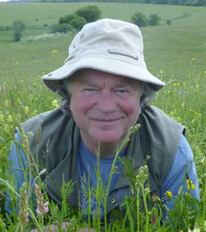|
Shaun Leonard, Director of The Wild Trout Trust came to talk to us last month. The subject of rivers and water quality has risen towards the top of society’s interest recently and that was borne out in the good turn out for this excellent speaker.
Shaun started by outlining the organisation whose aim is ‘helping and inspiring everyone to protect wild Trout and their habitat.’ The Trust partners many other likeminded organisations to pack a bigger punch for conservation, with a nationwide team of conservation officers. He then outlined the various problems that rivers are facing ~ Quality: namely pollution from sewage spills and from farming especially. Quantity: water extraction, especially in the South East of England and abuse, such as canalisation, obstructions, straightening, and dredging where the river is separated from its flood plain. Shaun then went on to present some interesting, thought-provoking interesting facts on trout especially on trout parasites. For example, on dissecting one he found the entire digestive system filled with worms. Another had choked on another fish whilst trying to eat another trout nearly as big as itself! Apparently eating other Trout is normal behaviour and trout fry can form a major proportion of their diet. Shaun finished his talk by showing us some practical projects The Trust have been involved with, from Scotland to Somerset. Locally this is the construction of a bypass channel to Daslett hatches at Sutton Mandeville, working with Nick Lawrence and David Holroyd, and habitat improvement on the Nadder. Trout fishing has progressed from manicured banks and stocking with large Rainbow Trout towards a completely different way of thinking where improving habitat to aid the recovery of wild Brown Trout in a wilder more natural environment. The Trust works with volunteers in practical demonstrations and fun days out as well as helping in restoration projects to remove weirs and reducing bunds for example. Shaun took questions throughout his excellent presentation and again at the end, covering subjects of close interest to the audience, so we all came away wiser and more informed. Peter Shallcross  For the last in our winter series of indoor meetings, in the Victoria Hall, Tisbury High Street, at 7:30pm on Thursday 11 April, what more appropriate topic – after such a wet winter - than that of Wild Fish, and the work of the Wild Trout Trust? The Wild Trout Trust provides expert advice and practical project delivery across the UK and Ireland, as well as working to inspire others and give them advice and practical skills, to improve and maintain lakes and rivers for the benefit of trout and all wildlife. We shall hear from Shaun Lennard, an unashamed ‘fish bloke’ whose childhood was spent in and on the Indian Ocean and in the trout streams of southern Ireland. Shaun’s whole professional life, after degrees in marine biology and pollution, has been spent in fishery management; he was Head of Fishery Studies at Sparsholt College near Winchester until 2009. Since then, he has been Director of the Wild Trout Trust. The threat to wildlife from pollution of the River Nadder is not a new topic for the Society. We’ve heard previously from David Holroyd, one of our members, and last year we heard from the Director of the Wessex Rivers Trust. The issue matters particularly here in Wiltshire and Hampshire where most of the planet's chalk streams are located; the reason the River Nadder as a tributary of the Hampshire Avon is a 'Special Area for Conservation'. Shaun is the ideal person to tell us more on these things, about the continuing pressure on our rivers more widely, whether from sewage treatment, from farms or other sources, the potential role of the government’s recent initiative to create Local Nature Recovery Strategies and a host of other topics. As with all our events, this meeting is free if you’re a member of the Society or under 21, and you’ll be very welcome to come as a guest visitor for the payment of £2. Dick Budden Mike Read is a wildlife photographer and he (and his wife) have spent many hours traversing the Somerset Levels recording the flora and fauna of this ancient land. For over 5,000 years, people have visited this area. Bordered by the sea at Bridgewater Bay, receiving the rain run-offs from the Mendips, Quantocks and Blackdown Hills, and being the flood plains of several low gradient rivers (the River Parrett, for example, declines by 11.5 inches over a stretch of 11 miles) the water levels are now more controlled than in ancient times and a variety of nature conservation organisations manage the land to support and encourage a wide and varied array of wildlife.
Having set out the parameters of the area, Mike introduced us to an ancient walkway, said to date from 3806 BCE precisely! This raised boardwalk was known to our ancestors as the Sweet Track and helped them to navigate their way through the reeds and vegetation, above the water while hunting and gathering their food and resources. Peat continues to be cut from the nutrient rich soils and reeds harvested for use in basket making and for thatch. Mike’s favourite product of the area is the apples used in cider making and having been drunk by everyone instead of the unclean water. Our talk started with a photograph of a telegraph pole with a curious carving of a bird on top. The bird was a dalmatian pelican. Remains of this species have been found preserved in the peat and so they must have lived there. We were treated to a selection of superb photographs of the Somerset Levels through the seasons, starting with spring and alder catkins, marsh marigold, lapwings, 6 species of heron, egrets, marsh harrier, peregrine, the heronry at Swale Wood (visited by several members last spring), the early nesting mistle thrush while it’s cousin, the song thrush, is still singing to attract a mate, and the first migrants, chiff chaff and blackcaps. Nestled down in the reeds, we saw images of bittern and then a series of shots of great crested grebe doing a cat display followed by a weed dance, all part of their courtship rituals. The number of curlews has increased since the nature bodies have had a say in the optimum level of the water. The first butterflies and dragonflies were photographed among the water lilies and iris while a hobby was captured with a dragonfly in its beak. In summer, the bees are swarming and the yellow and white flowers of spring are superseded by the darker, richer colours of great willowherb, purple loosestrife and tufted vetch. Swallows arrive and the great egret chicks fledge. Kingfisher, moorhens, mallards and others are hunted by buzzards and marsh harriers. Towards the end of the summer, apples ripen, ditches are cleared and migrants pass through including the whitethroat and osprey. Hops, hips, elderberries and blackberries glisten in the autumn sunshine and provide food for speckled wood and red admirals. Fungi appears including fairy ink caps and glistening ink caps. Flocks of lapwing grow in number day by day. Golden plover arrive from the northern UK and Iceland. Mike told us about the successful reintroduction programme of the common crane and how many pairs are now breeding on the levels and some pairs have moved away to South Wales. In winter, lapwings, golden plovers, black-tailed gobwits and cormorants can be seen and wetland fowl of all kinds will be displaying and wing flapping in order to attract a mate. During the winter months, it is the best time to see bearded tits, short-eared owls and barn owls and also the now world famous murmurations of starlings. All captured through Mike’s lens and accompanied by interesting and amusing anecdotes, we are eagerly anticipating our visit to the levels this summer. The society’s visit to Ham Wall is on Saturday June 8th, 2024. Emma Procter Our next meeting, at the Victoria Hall on Tisbury High Street on Thursday 14th March at 7:30pm (doors, and the bar will be open from 7:00) will hear from Mike Read who is going to share with us his view of ‘The land of the Somer people’.
Mike, who lives at Ringwood in Hampshire, has worked as a free-lance wildlife photographer for over 40 years. His pictures are often used as nature illustrations, including in books he has written or co-authored such as 'The Robin' & 'The Barn Owl' both published by Blandford Press and a number on aspects of the New Forest: 'New Forest Moods', 'Perfect New Forest', 'Spirit of the New Forest', 'Spirit of the New Forest Pony', and 'New Forest National Park' all published by Halsgrove Publishing and 'Red Kite Country' published by Wild Guides Ltd. The Land of the Somer People, is one of a number of talks Mike delivers to societies like ours, illustrated with pictures he has taken over the years. He will take us through a typical year on the Somerset Levels, a wonderful place to watch wildlife at any time of year. The Levels have changed greatly since Stone Age man first visited the area and laid bundles of hazel sticks to be able to cross the boggy ground. Over 5,000 years later, pollarded willows, pumping stations, drainage ditches or ‘rhynes’ and other man-made constructions, have created a very controlled landscape. But wildlife still thrives with birds, flowers and insects all enjoying the Levels’ landscapes and the nature reserves that have been established. In the spring and summer, flowers add colour to the place as do butterflies, dragonflies and damselflies. Birds include up to six species of the heron family, raptors such as marsh harriers, buzzards, peregrines and hobbies as well as huge flocks of wintering waders and wildfowl. There is the successful reintroduction of common cranes to the area and the marvellous spectacle of the weaving, ever-changing patterns of ‘murmurations’ as tens of thousands of starlings fly in to roost in the reedbeds at sunset, while hawks and harriers try to secure a final meal of the day. The programme for 2024/5 is now available and can be found on the pages Field Trips and Talks & Films.
We shall be publishing a more detailed guide to the Field Trips in the near future. (c) Natural England (male hen harrier)
The talk last week given by Flemming Ulf-Hansen and Sofia Muñoz from Natural England was illustrated with photographs and videos from their project headquarters near Salisbury Plain where their captive hen harriers from France have spent a year acclimatising to their new location, surrounded by species rich grassland. The deliberately low maintenance management of the land on Salisbury Plain makes this location ideal for hen harriers as it is richly populated with voles and farmland birds like corn buntings, linnets, pipits and skylarks, which are the mainstay of their diet. Hen harriers nest on the ground, preferring deep heather on moors or tucked down amongst high arable crops. It is thought that 50-60% of the young die in any year as they are vulnerable to predators such as foxes, badgers and stoats. Early harvesting in arable fields also brings danger if the nests remain undetected. The captive hen harriers in France and Spain have typically been rescued as fledglings from abandoned nests. Male hen harriers are polygynous so they may need to supply several females with food, which adds another precariousness to their young’s chances of reaching adulthood. With 5-10 journeys to each nest per day, bringing food in the first 15 days, a male hen harrier has the sole responsibility for nourishing the chicks before the female begins hunting for supplementary food. With no parental lessons in hunting given, the juveniles have to adapt fast to survive when the time comes to leave the nest. Since hen harriers like to return to their natal area, it is hoped that any juveniles born this year will provide the breeding stock for the future. For further information about this interesting breeding project and Natural England’s outreach work with gamekeepers and the farming community, please go to their Project blog. Rob Farrington, Wilder Dorset Project Manager at Dorset Wildlife Trust, came to give us a talk about the development of the Wild Woodbury community rewilding project, from land acquired by Dorset Wildlife Trust at Bere Regis in 2021.
It used to be an intensive arable farm, with some square areas of woodland, but was very difficult to farm due to excessive water which prevented access to farm machinery during great part of the year. Huge drainage ditches had been historically installed to try to alleviate the situation. Since its acquisition, the management practices by DWT have consisted in the restoration of natural processes, with inspiration from the rewilding movement and the Wicken Fen project. For example, the natural hydrology of the site is in process of being restored by removing ditches and drains, artificial fertilisation has stopped and extensive grazing by cows and ponies at low stocking levels has been implemented… Pigs will be introduced at a later stage. According to Rob, the rate of change has been enormous and unexpected processes have been observed, such as the creation of spoil heaps from mice and voles. The site has a very varied geology, which makes the changes very interesting. We were shown pictures of before and after to demonstrate the changes. Biological surveys have shown that the numbers of invertebrates have increased (for example, butterflies have increased 62%), and therefore the number of predators of invertebrates (for example, harvest mice and birds such as nightjars and short-eared owls). The colonisation of the former arable land by heathland and acid grassland species suggests that the site may revert into a wet heath. The river leaving the site used to be brown with run-off; now it is clear, the site retains a lot of water which prevents flooding in the surrounding roads. We are looking forward to our visit of the site when we resume our outings this spring. In the meantime, you can follow the news on Dorset Wildlife Trust website’s blog: www.dorsetwildlifetrust.org.uk/blog/tag/wild-woodbury Inés López-Dóriga  On Thursday 11th January at 7:30pm in the Victoria Hall on Tisbury High Street, we shall be hearing from Rob Farrington, who has been managing the Wild Woodbury Project from the outset. Rob will describe the work carried out to date, and discuss the prospects for the future and lessons to be drawn from this project for the countryside more widely. As always, our events are free if you’re a member of the Society or under 21, and you’ll be very welcome to come as a guest visitor for the payment of £2. John Akeroyd, who described himself as a botanist and field taxonomist, has a lifetime's experience of working with plants and a focus for the last 20 years on dry grasslands in Romania. The latter is an example of species-rich temperate grasslands which are extremely important for their diversity, although they are becoming rarer. Thankfully, given a chance, nature will return and flourish and it is the mixed agricultural landscapes which have proven to be the most diverse.
With numerous illustrations and amusing asides, John described how important the plants around us are to our economy, our health and how their flowers and foliage have been absorbed into our cultures. While many of our staple food plants such as wheat, barley, flax, and olive oil derive from plants which spread out from the fertile crescent, others which have gone on to dominate world food trade such as maize, haricot beans, potatoes and squash originate in the Americas. Success or otherwise of crops, and the spread of crop disease has had an impact on history as has the exploitation of crops and people for trade. Plants or their flowers and foliage are often potent symbols of nations or culture for example the Scottish thistle, the English rose, the Irish Shamrock and the Welsh daffodil and leek. At a time when sustainability is key, plants that can be used then recycled such as cork, hessian, or paper are important contributors. Since early times plants have had a vital role in medicines first as herbal remedies or even contraceptives and more recently as sources of compounds providing the inspiration of synthetic drugs. John showed us that while it is easy to take all the plants around us for granted, they play multiple essential roles in our world. Andrew Graham We shall be starting earlier than usual at 6:45pm at the Victoria Hall, Tisbury High Street for mulled wine, mince pies and nibbles before hearing from the world-renowned botanist Dr John Akeroyd. John always loved plants, even before he was taught at school by the famous botanist Oleg Polunin. He graduated from the Universities of St. Andrews and Cambridge, and held fellowships at the Universities of Trinity College, Dublin and Reading, researching European flora. Lecturer, tour guide, writer and editor, he co-founded Plant Talk, the first global magazine for plant conservation.
He has written or edited seventeen books, including the best-selling Collins Wildguide:Flowers and The Encyclopedia of Wildflowers and many articles on plants, people and places. |
Photo: Avocets (Izzy Fry)
The headers display photos taken by our members. Do get in touch via the Contact Form if you'd like to submit a photo for selection.
Archives
May 2024
Categories
All
|



 RSS Feed
RSS Feed